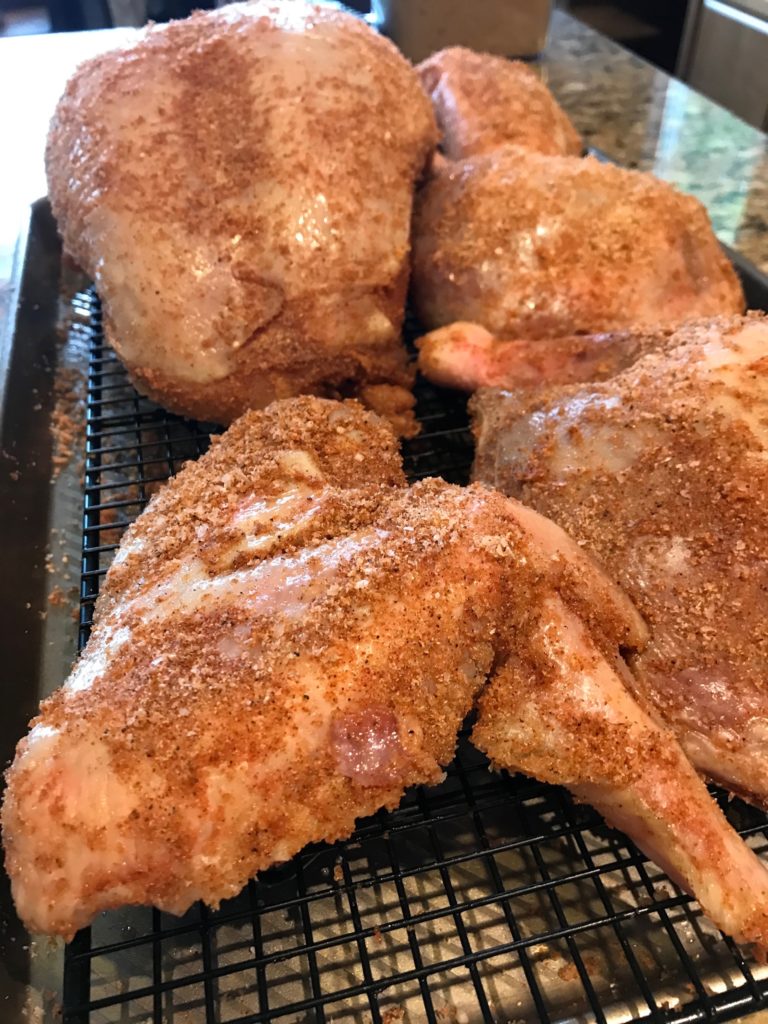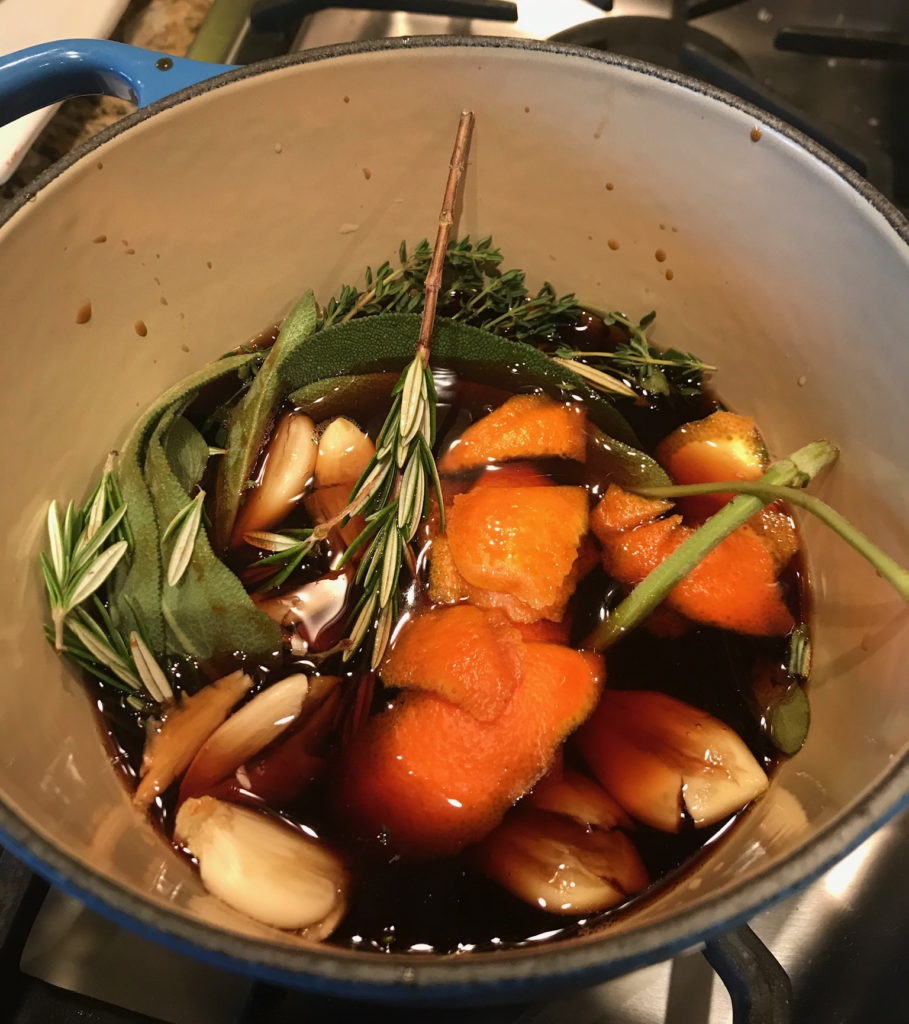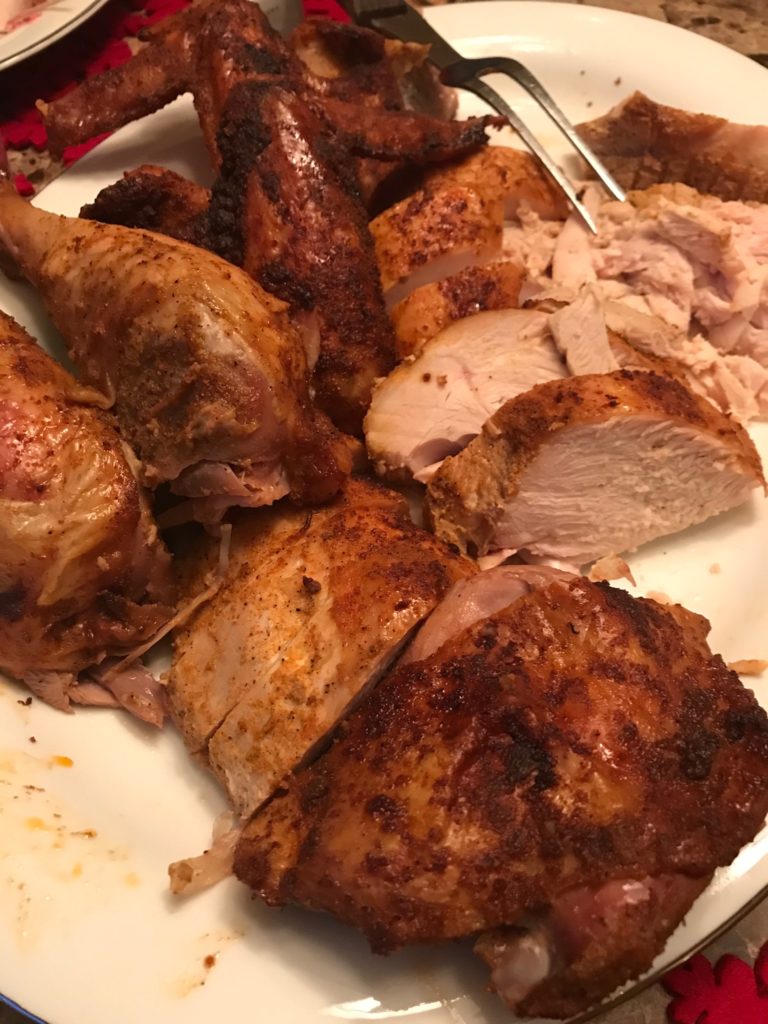On Thanksgiving, I made a turkey for dinner. Now, this is a daring feat for me. Turkey is my nemesis. It’s never done according to plan. I’ve followed recipes. Doesn’t matter. The white meat cooks faster than the dark meat. In fact, the thighs are usually raw while the breast meat is perfectly done. I’ve tried tenting the breast and continue roasting, but I just end up with dry meat. One year was so bad that I ended up hacking up the turkey after the breasts were done and finished off the legs and thighs separately. Ugliest. Turkey. Ever.
I’m a faithful reader of Bon Appétit. When they published this year’s turkey recipe, Expertly Spiced and Glazed Roast Turkey, not only did I trust them, I saw the brilliance in their method. It was similar to my hacked up turkey, but done in a much smarter, less critical way. You ask the butcher to cut it up for you into five pieces that not only solves when the turkey is done problem, but also the carving issue (which I haven’t even delved into). Each piece cooks at the same rate because the meat is properly distributed. Wow. Why didn’t I think of that?
So when I made it for Thanksgiving, everyone agreed that this non-traditional turkey was amazing and should be repeated on Christmas. I was a bit worried that my Thanksgiving success was a fluke, but I put on my big girl pants and decided to try it again. I was so brave that I didn’t even buy a backup ham. Fortunately, I didn’t need it.
It uses a dry brine instead of the messy wet brine that requires you to soak your turkey in a bucket for a couple of days (what a mess that was…never again).
Let me interject that you need to have a meat thermometer, preferably an instant read one. If you are roasting a turkey without one, you are very confident. Me…not so much.
This recipe suggests that you preorder your turkey and nicely ask your butcher to cut it up into five pieces plus remove the backbone. You can purchase a frozen turkey, thaw it, and cut it up at home. Alas, I’m not that patient or talented. Therefore, I used the humorous script Bon Appétit prepared for me, “Hello, talented and smart and underappreciated butcher [pause for uncomfortable laughter], I’d like to purchase a 10-to-12-pound turkey, cut into five pieces: the legs, wings, keep the breast whole, backbone removed. Yes, I’m doing that ridiculous Bon Appétit recipe. Yes, it better not suck.” I love Bon Appétit. My butcher thought I was a little weird.
Back safely at home, away from the deadpan eyes of my quizzical butcher, I made the rub for the brine: pepper, kosher salt, garlic powder, onion powder, smoked paprika, and brown sugar. I don’t have a spice mill or mortar/pestle so I used ground pepper, and it turned out fine. I used a 10-12 pound turkey and had plenty of rub, but I used it all. Can one have too much rub? Don’t answer that.
Sit your turkey on a cookie rack on a baking sheet. This helps circulate the air to the bottom of your turkey and later, you’ll use the same set-up to roast it. Rub the seasonings on the turkey. I know. This can be unpleasant, but (and I mean this in the best way possible) get over it. It’s better than if it was a whole turkey where you have to dig around for those mysterious parts you won’t be using. Ick. Did I mention turkeys are my nemesis?

Now the fun part. Shove everything to the corners of your fridge to make way for this bird to habitat your fridge for the next two days. Don’t cover it either. I was less than thrilled of the smell it left behind, but it will go away. After two days, the rub will be absorbed and the skin will be dry. This is a good thing because dry skin will make the skin crispy and beautifully brown.

Pull it out of the fridge. Let it sit for 2-3 hours. Don’t worry. Bacteria will not grow and give your guests food poisoning. The turkey should not go from a cold refrigerator to a hot oven. It’ll freak out and not cook evenly. You need to bring the bird up to room temperature first. I recommend putting your dog outside if you have one.
The turkey will roast in two phases, first at a high heat to brown it and then at a lower heat for longer to cook it through. During the first phase, make the glaze, which you’ll baste on the turkey every 20 minutes during the second phase. I have to admit that got distracted while eating the Brie appetizer and only basted once. It turned out delicious anyway.
The glaze is essential and gives it that sweet, Christmas-spiced taste, which is pretty amazing considering there are no spices in the glaze. I attribute this to the brown sugar and garlic, with some help of the sage.
Combine all the glaze ingredients and simmer for 10-15 minutes until it’s slightly thickened. After I removed it from the heat, I found that it continued to thicken so take this into account when you are determining if it’s thick enough. I made a double batch because I didn’t want to run out, which I did the first time. Then again, the first time I remembered to baste it every 20 minutes. Doh!

The recipe also calls for adding water to the baking pan. This helps it cook and keep it moist. Sorry. I had to use that word. There’s no other way to describe it. Let’s move on.
Using an instant-read thermometer (but any meat thermometer will do…just have one…trust me on this one), start checking on the turkey at the 50 minute mark. Make sure that the thickest part of the breast is 150F and the thigh is 170F. If it’s not, glaze it again, and check every 5-10 minutes.
When it’s done, tent (aka cover) it with foil to keep it warm and let it sit for 30-60 minutes. I like to take this time to heat up the sides I made the day before. When everything is ready, slice up the white meat and separate the leg from the thigh. The easiest way to cut the leg and thigh is to find the joint by bending it a couple times and cut there.
The turkey was so good that I nearly forgot to take a picture of the final product. Everyone was already digging in.

Get the recipe: Expertly Spiced and Glazed Roast Turkey. You won’t be disappointed.
